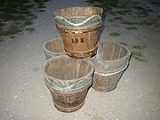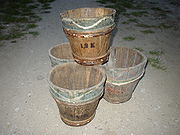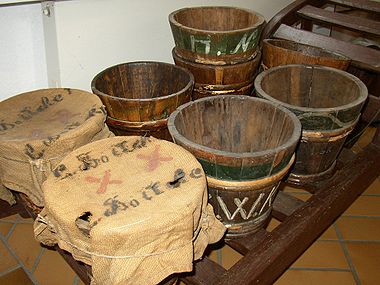
Tiene
Encyclopedia
Tiene, sometimes also called Tine or Obsttiene, was a special container for transporting wine
and fruit
. These were used until shortly after the First World War, mostly in the Brandenburg
city of Werder
in northern Germany. Normally the wooden tubs were carried on people's backs to small boats and shipped on the Havel
River to market stalls in Berlin
.


 The fruit growing-area around the river island city of Werder has a long tradition, back to the fruit fields of the Cistercian monks in the Lehnin Abbey
The fruit growing-area around the river island city of Werder has a long tradition, back to the fruit fields of the Cistercian monks in the Lehnin Abbey
, one of the oldest cloisters in Brandenberg, established in 1180. The abbey lands produced large amounts of grape
s and other fruits which were processed and transported to Berlin.
The term Tiene comes from the wooden vats in which the grapes were pressed for processing into wine, used originally in the 16th and 17th centuries. In the 19th century, fruit growers transferred the term onto the small wooden tubs in which they transported their fruit.
Three cooper
s worked on the island and it is to be supposed that the cooper's trade began in the 18th century in Werder. Before the Tienen were sold to the fruit farmers, the coopers had to calibrate them. The Tienen were dried and then weighed and the dead weight was branded on the outside. A new Tiene for cherries with a capacity of 7 to 9 pounds cost sixty Pfennig
in 1908. A Tiene for raspberries weighed 50 to 60 pounds.
Werder pioneered these transport containers and when it introduced the Chip basket (made from wooden chips) in 1910, the Tiene quickly lost their former importance.
remembers walking along the Brandenburg March on his way to school in Berlin. His path led him through crowds of the Werderschen, his name for the inhabitants of Werder, every morning between Friedrich's bridge and the Herkules-bridge at its original location on Burg-street:
Wine
Wine is an alcoholic beverage, made of fermented fruit juice, usually from grapes. The natural chemical balance of grapes lets them ferment without the addition of sugars, acids, enzymes, or other nutrients. Grape wine is produced by fermenting crushed grapes using various types of yeast. Yeast...
and fruit
Fruit
In broad terms, a fruit is a structure of a plant that contains its seeds.The term has different meanings dependent on context. In non-technical usage, such as food preparation, fruit normally means the fleshy seed-associated structures of certain plants that are sweet and edible in the raw state,...
. These were used until shortly after the First World War, mostly in the Brandenburg
Brandenburg
Brandenburg is one of the sixteen federal-states of Germany. It lies in the east of the country and is one of the new federal states that were re-created in 1990 upon the reunification of the former West Germany and East Germany. The capital is Potsdam...
city of Werder
Werder (Havel)
Werder , is a town in the state of Brandenburg, Germany, located on the Havel river in the Potsdam-Mittelmark district, west of the state's capital Potsdam.Werder has a long and rich history and is a nationally recognized Erholungsort – a government designation given to...
in northern Germany. Normally the wooden tubs were carried on people's backs to small boats and shipped on the Havel
Havel
The Havel is a river in north-eastern Germany, flowing through the German states of Mecklenburg-Vorpommern, Brandenburg, Berlin and Saxony-Anhalt. It is a right tributary of the Elbe river and in length...
River to market stalls in Berlin
Berlin
Berlin is the capital city of Germany and is one of the 16 states of Germany. With a population of 3.45 million people, Berlin is Germany's largest city. It is the second most populous city proper and the seventh most populous urban area in the European Union...
.

History


Lehnin Abbey
Lehnin Abbey is a former Cistercian monastery in Lehnin in Brandenburg, Germany. Since 1911 it has accommodated the Luise-Henrietten-Stift, a Protestant women's community.-History:...
, one of the oldest cloisters in Brandenberg, established in 1180. The abbey lands produced large amounts of grape
Grape
A grape is a non-climacteric fruit, specifically a berry, that grows on the perennial and deciduous woody vines of the genus Vitis. Grapes can be eaten raw or they can be used for making jam, juice, jelly, vinegar, wine, grape seed extracts, raisins, molasses and grape seed oil. Grapes are also...
s and other fruits which were processed and transported to Berlin.
The term Tiene comes from the wooden vats in which the grapes were pressed for processing into wine, used originally in the 16th and 17th centuries. In the 19th century, fruit growers transferred the term onto the small wooden tubs in which they transported their fruit.
Capacity and construction
A Tiene holds approximately 7 liters, or 3.5 to 4 kg mass, depending on the kind of fruit. The oak tubs weigh 1.8 kg, while tubs made from spruce weigh 1.6 kg. The conical Tienen were prepared for shipping by covering the top with linen cloth. By circa 1900 more than 200,000 Tienen were in use in the Werder region and their production was a significant craft industry in the town.Three cooper
Cooper (profession)
Traditionally, a cooper is someone who makes wooden staved vessels of a conical form, of greater length than breadth, bound together with hoops and possessing flat ends or heads...
s worked on the island and it is to be supposed that the cooper's trade began in the 18th century in Werder. Before the Tienen were sold to the fruit farmers, the coopers had to calibrate them. The Tienen were dried and then weighed and the dead weight was branded on the outside. A new Tiene for cherries with a capacity of 7 to 9 pounds cost sixty Pfennig
Pfennig
The Pfennig , plural Pfennige, is an old German coin or note, which existed from the 9th century until the introduction of the euro in 2002....
in 1908. A Tiene for raspberries weighed 50 to 60 pounds.
Werder pioneered these transport containers and when it introduced the Chip basket (made from wooden chips) in 1910, the Tiene quickly lost their former importance.
Significance of the industry
Theodor FontaneTheodor Fontane
Theodor Fontane was a German novelist and poet, regarded by many as the most important 19th-century German-language realist writer.-Youth:Fontane was born in Neuruppin into a Huguenot family. At the age of sixteen he was apprenticed to an apothecary, his father's profession. He became an...
remembers walking along the Brandenburg March on his way to school in Berlin. His path led him through crowds of the Werderschen, his name for the inhabitants of Werder, every morning between Friedrich's bridge and the Herkules-bridge at its original location on Burg-street:
Sometimes it probably also happened that we saw the late » second meeting « of the Werderschen, from the Unterbaum, rowing big boats close with Tienen full of fruit, while on the oar benches twenty women sat and moved their oars and the heads with their panniers hats moving with equal energy. [...] The air swam in a refreshing smell, and the domed construction of the inverted Tienen piled up about one another. This interested us more than the comfortable construction of Castle Monbijou and I am sad to say, , also more interesting than the column wood of the New MuseumNeues MuseumThe ' is a museum in Berlin, Germany, located to the north of the Altes Museum on Museum Island.It was built between 1843 and 1855 according to plans by Friedrich August Stüler, a student of Karl Friedrich Schinkel. The museum was closed at the beginning of World War II in 1939, and was heavily...
of Schinkel.
External links
- Tiene. From the German-language Wikipedia. Retrieved February 6, 2008, and containing the internal reference:
Literature
- Theodor Fontane: Wanderungen durch die Mark Brandenburg. Part 3-rd Havel's land. (1-st edition in 1873.) citation after the issue: Nymphenburger Verlagshandlung, Munich in 1971, Frankfurt am Main, Berlin. Page 418. ISBN 3-485-00293-3. Because of many different issues the tip: Chapter Die Werderschen, 1-st segment. (German)
- Dr. H.-Joachim Koch: Blütenstadt Werder/Havel Heimatgeschichtliche Beiträge 1984 Page 18-21 no ISBN (German)

